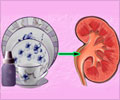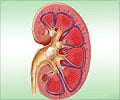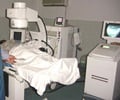
"This paper reports the discovery of one of the first targeted drugs specifically developed to reverse fibrosis and regenerate the kidney," said senior author Raghu Kalluri, MD, PhD, Chief of the Division of Matrix Biology at BIDMC and Professor of Medicine at Harvard Medical School (HMS). "We're optimistic about the benefits, but the real proof will come from clinical testing."
Chronic kidney disease is becoming a major public health problem, partly due to the increase in obesity, diabetes, hypertension and an aging population. It affects one out of every 10 people older than 20, and is most prevalent in those over 60. Most people with impaired kidney function are in the early stages and have no symptoms, but deteriorating kidneys significantly raise the risk of death by cardiovascular disease. Those who survive heart attacks and strokes can progress to end-stage renal disease, which requires dialysis in most cases or transplants when donor kidneys are available.
"The field is desperate for new interventions that can halt or slow the progression of renal failure," said nephrologist Qais Al-Awqati, MB, ChB, a professor of medicine and physiology at Columbia University and immediate past editor of the journal Kidney International. Al-Awqati, who was not involved in the study, notes that kidney disease is the third leading cause of death in the U.S.
In the kidneys and other organs, fibrosis develops from normal repair mechanisms that do not stop. Scar tissue slowly builds up and replaces the working cells of the organ. In 2003, Kalluri's lab reported that the destructive fibrosis in mice can be countered by the human protein BMP-7, originally named for its ability to spur bone growth. A manmade version of BMP-7 is approved by the U.S. Food & Drug Administration (FDA) to help repair long bones and vertebrate disks. However, the large protein needs to be injected or surgically implanted and, therefore, is not useful for long-term treatment protocols.
Kalluri and his colleagues continued their studies, seeking a smaller molecule that could be taken by mouth in a pill form in order to more specifically exert its protective effect on the kidney. Probing deeper into the biology of the kidney, they identified the protein Alk3, which is not the protein's primary partner in bone.
Advertisement
Researchers in the Kalluri lab used the experimental compound to document the role of the receptor in reversing the fibrosis and allowing normal tissue to regenerate in one mouse model after another. "This receptor must be present for the new molecule to function," said Kalluri. Working through the receptor, the molecule suppressed inflammation, cell death and fibrosis formation, as well as reversing established fibrosis and allowing kidneys to regenerate functional cells, he adds.
Advertisement
"Targeting the receptor not only stops fibrosis, it removes established fibrosis, and it works in combination with an existing drug used in patients," Kalluri notes. "The next step is to test this molecule in the clinic."
The mice studies are "a good first step," said Al-Awqati. "It will be interesting to pin down the role of the BMP-7 pathway in kidney fibrosis in people."
Going forward, Kalluri's group will continue to study these molecular players and their roles in fibrosis in other organs, including the liver, lung, intestine and heart in the hopes of expanding the experimental-drug pipeline. "If you don't have a pipeline of experimental drugs, how will you succeed in coming up with new drugs?" he asks.
Source-Eurekalert















